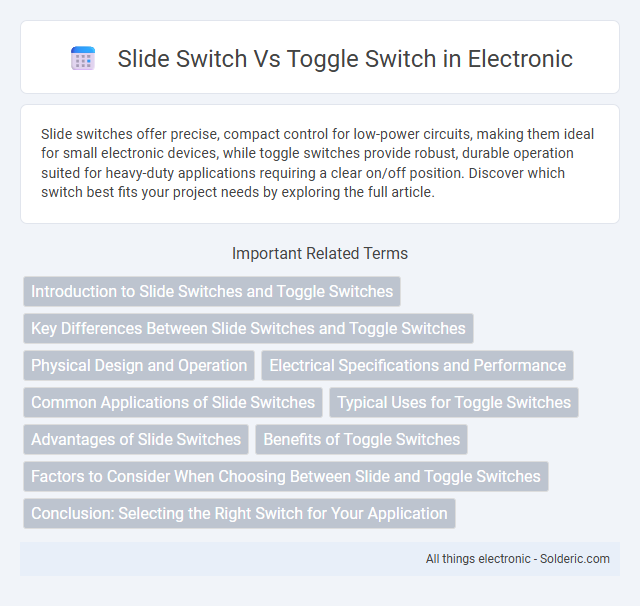Slide switches offer precise, compact control for low-power circuits, making them ideal for small electronic devices, while toggle switches provide robust, durable operation suited for heavy-duty applications requiring a clear on/off position. Discover which switch best fits your project needs by exploring the full article.
Comparison Table
| Feature | Slide Switch | Toggle Switch |
|---|---|---|
| Operation | Sliding mechanism moves contacts | Lever flips up or down |
| Size | Compact, low profile | Typically larger and protruding |
| Application | Small electronics, PCB mounting | Industrial, automotive, appliances |
| Durability | Moderate, suitable for light use | High, designed for heavy use |
| Switch Positions | Usually 2 or 3 positions | 2 or more positions, often maintained |
| Mounting Type | Surface mount or through-hole | Panel mount commonly |
| Cost | Generally lower cost | Often higher cost |
Introduction to Slide Switches and Toggle Switches
Slide switches operate by sliding a button or knob back and forth to open or close an electrical circuit, making them ideal for compact devices requiring simple on/off control. Toggle switches use a lever or handle that flips between positions, offering more tactile feedback and durability for heavier-duty applications. Your choice between slide and toggle switches depends on factors like device size, usage frequency, and required switch robustness.
Key Differences Between Slide Switches and Toggle Switches
Slide switches feature a linear motion mechanism ideal for low-profile applications, while toggle switches utilize a pivoting lever for easy visual status indication. Slide switches are typically used in compact electronic devices for on/off or circuit selection functions, whereas toggle switches suit robust industrial equipment requiring durable and tactile feedback. The primary distinction lies in their actuation style and ergonomic suitability, influencing their integration into various electrical systems.
Physical Design and Operation
Slide switches feature a linear mechanism that moves a small knob or lever along a straight path, enabling precise on/off control with minimal physical effort. Toggle switches operate via a pivoting lever that flips between positions, offering a distinct tactile feedback and often accommodating higher current loads. Your choice between these switches depends on the desired user experience and space constraints, as slide switches are compact and discreet while toggle switches provide robust operation and visibility.
Electrical Specifications and Performance
Slide switches typically operate at lower current ratings, often around 0.5 to 3 amps, making them ideal for low-power applications, whereas toggle switches can handle higher currents up to 15 amps or more. The contact resistance in toggle switches is generally lower, ensuring better conductivity and durability under frequent switching conditions. When selecting a switch, consider Your device's voltage and current requirements to optimize performance and reliability in your electrical circuit.
Common Applications of Slide Switches
Slide switches are commonly used in small electronic devices such as remote controls, flashlights, and portable audio players due to their compact size and ease of operation. They are ideal for low-voltage circuits where simple on/off control is required, making them prevalent in consumer electronics and handheld gadgets. Slide switches also find applications in computer peripherals, battery-powered toys, and small appliances where reliable switching with minimal space is essential.
Typical Uses for Toggle Switches
Toggle switches are commonly used in industrial machinery, automotive applications, and household appliances where robust and reliable on/off control is required. Their durable design allows them to handle higher current loads, making them ideal for controlling motors, lights, and power tools. If your project demands frequent switching with clear tactile feedback, toggle switches provide a user-friendly and long-lasting solution.
Advantages of Slide Switches
Slide switches offer compact design and smooth operation, making them ideal for space-constrained electronic devices. Their low-profile mechanism reduces accidental activation, enhancing user safety and device reliability. These switches also provide precise control and longer durability in applications such as handheld gadgets, consumer electronics, and instrumentation panels.
Benefits of Toggle Switches
Toggle switches offer robust durability and reliable performance in demanding industrial and automotive applications. Their easy-to-use lever design allows for quick, tactile feedback and clear ON/OFF indication, enhancing user control and safety. Toggle switches are available in various amperage ratings and environmental protections, making them versatile for high-current and harsh condition use.
Factors to Consider When Choosing Between Slide and Toggle Switches
When choosing between slide switches and toggle switches, consider factors such as space constraints, switching action preference, and durability requirements. Slide switches are compact and ideal for low-profile applications where precise positioning is needed, while toggle switches offer a robust, tactile click suited for frequent or heavy-duty use. Your specific project demands and operational environment will dictate which switch type provides the optimal balance of functionality and reliability.
Conclusion: Selecting the Right Switch for Your Application
Slide switches provide compact, low-profile solutions ideal for circuit boards with limited space, offering reliable on-off control with smooth operation. Toggle switches deliver robust performance suitable for applications requiring more tactile feedback and durability, often featuring higher current ratings and easier accessibility. Choosing the right switch depends on balancing space constraints, electrical requirements, and user interaction preferences to ensure optimal functionality and longevity in your specific application.
slide switch vs toggle switch Infographic

 solderic.com
solderic.com